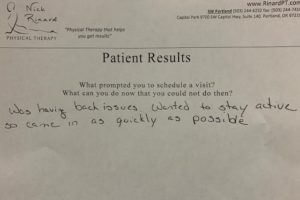After what seems like an eternity, it is finally time to prepare the garden and start seeds!
Here are a few tips to keep you in the dirt all spring and summer long.
· Avoid prolonged bending. Kneeling on a pad or bringing a stool outside will save your back and your knees.
· Clear your path, and get additional help before moving or lifting heavy pots or bags of soil.
· When lifting, be sure that you keep your back straight and lift from your legs.
· Be aware of your posture while gardening. Many of us are prone to slouching, so take note and sit up straight.
· Call Nick Rinard Physical Therapy right away if you notice any back pain.
· Getting in sooner than later equals fewer visits and you are back to doing what you love.
More

When you start feeling pain it’s REALLY best to schedule a visit right away.
Marge successfully completed physical therapy and is free of back pain in just 6 visits!
“Was having back issues. Wanted to stay active so came in as quickly as possible.”
As we always say, “Don’t deal with the pain, heal it… today!”
More
When asked “WHAT IS IT ABOUT OUR CLINIC THAT MADE YOU CONFIDENT ABOUT SENDING US YOUR PATIENTS?” they replied……
- “You get great results.”
- “Good feedback in timely fashion.”
- “Customer Service – great!”
- “Positive Results!”
- “It works for many patients, quickly – minimal visits.”
- “It empowers the patient life-long.”
- “If it does not work you’ll know within 2 visits.”
- “Your group is kind, responsive, courteous.”
- “Recommendation of other providers.”
- “Courtesy shown to patients.”
- “Results!”
- “Excellent understanding and implementation of the McKenzie protocol.”
- “Thorough assessment and plan.”
- “Good results.”
More
Technically speaking your knees (the joint parts) do not affect stride since running is a “mid-range” motion. Walking, on the other hand, does involve end range extension, so limited extension could have an effect – but not in running. Pain in the knee is likely to affect your ability to tolerate a running stride, and your body will find ways to avoid pain – thus affecting your stride in varying ways. There is no typical way this happens, so if you have knee pain, you need to have a good mechanical examination to find out how to best treat or manage it.
More
Low back pain is one of the most common causes of disability in the world. A recent study found that “Out of 291 conditions studied in the Global Burden of Disease 2010 Study, LBP ranked highest in terms of disability (YLDs), and sixth in terms of overall burden.” With a large range of different types of back pain it can be extremely frustrating finding relief from this type of pain.
Luckily there has been a large effort to find the best approach to dealing with low back pain. A 2018 study comparing healthcare costs for patients with a diagnosis of low back pain between the ages of 18 and 64. Interventions studied included differences in opioid prescription, health care utilization, and timing of PT intervention. This study found that patients who saw a PT at first had a lower utilization of high‐cost medical services (MRI, surgical intervention, emergency room visits) as well as lower opioid use.
Another study looked at the differences in long term outcomes in patients with spinal stenosis given PT or surgery. The results of this study after 2 years found that patients “did not differ significantly between patients who had undergone surgery and those who avoided surgery.” This shows that physical therapy alone is a much safer, cheaper, and equally effective choice.
Understanding your back pain and using your own body to fix itself has proven to be the least expensive and best outcome tool when dealing with low back pain. Therefore be your own advocate when dealing with new or recurring back pain and try PT first!
Frogner, B. K., Harwood, K., Andrilla, C. H. A., Schwartz, M., & Pines, J. M. (2018). Physical Therapy as the First Point of Care to Treat Low Back Pain: An Instrumental Variables Approach to Estimate Impact on Opioid Prescription, Health Care Utilization, and Costs. Health services research.
Hoy, D., March, L., Brooks, P., Blyth, F., Woolf, A., Bain, C., & Murray, C. (2014). The global burden of low back pain: estimates from the Global Burden of Disease 2010 study. Annals of the rheumatic diseases, 73(6), 968-974.
Minetama, M., Kawakami, M., Nakagawa, M., Ishimoto, Y., Nagata, K., Fukui, D., & Sakon, N. (2018). A comparative study of 2-year follow-up outcomes in lumbar spinal stenosis patients treated with physical therapy alone and those with surgical intervention after less successful physical therapy. Journal of Orthopedic Science, 23(3), 470-476.
More

